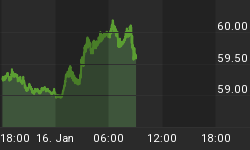In recent articles I have been describing a new "hybrid" forecasting model I am developing based on the work of George Lindsay. Lindsay's forecasting techniques (explained in my new book "George Lindsay Training Course; 1921-1942 Long Cycle") were used to time the beginnings and endings of both secular and cyclical markets (bull and bear) in the Dow Jones Industrial index. My Hybrid-Lindsay approach uses Lindsay's concept of Middle Sections and combines it with my own interval approach to forecast short-term highs and lows that Lindsay didn't bother with.
In last week's Commentary I wrote that this new approach was forecasting a low to the September decline on Monday, 10/7/13. As it turned out, the closing low in the Dow was on Tuesday. That was followed by a rally of over 400 points on Thursday/Friday. Now the question becomes when does the current rally end?
A flattened top (similar to the flattened tops which played a role in forecasting the highs on August 2nd and September 18th) is found in September, 2009. The high of that top (point E) occurred on 9/23/09 and counts 741 calendar day to the low of the basic cycle on 10/4/11. A Middle Section count to a low, forecasts a high, an equidistance (i.e. 741 days) into the future. Counting 741 days from the low on 10/4/11 forecasts a high on 10/14/13.

![]() Larger Image - Figure 1
Larger Image - Figure 1
A Middle Section count can be off by a few days and should be considered a point-forecast with a surrounding window of time in which to expect a turn in the market. Narrowing down this margin of error is my own contribution and why I call this a "hybrid" Lindsay model. This approach uses regularly repeating intervals of time to forecast market turns but without the corresponding Middle Section forecast it would not tell us whether the expected turn is to be a high or a low.
An interval of 27 days can be seen in Figure 3. It points to a turn on 10/15/13 and could extend to 28 days to forecast a turn on 10/16/13. Combined with the Middle Section forecast telling us to expect a top on 10/14/13 this seems to be a good reason to expect last week's rally to peter out early this week.
This will be the final article on the Hybrid Lindsay model for several weeks as the next signal for a bottom in the Dow isn't until 11/25/13. An expected low then matches the seasonal tendency for stocks to rally in the holiday shortened week of Thanksgiving in the U.S.A. Does that mean equities should be expected to decline throughout the 10/14/13-11/25/13 period? It seems unlikely but certainly not impossible. It is something we will all find out together.
Request your free copy of the October Lindsay Report at Seattle Technical Advisors.


















